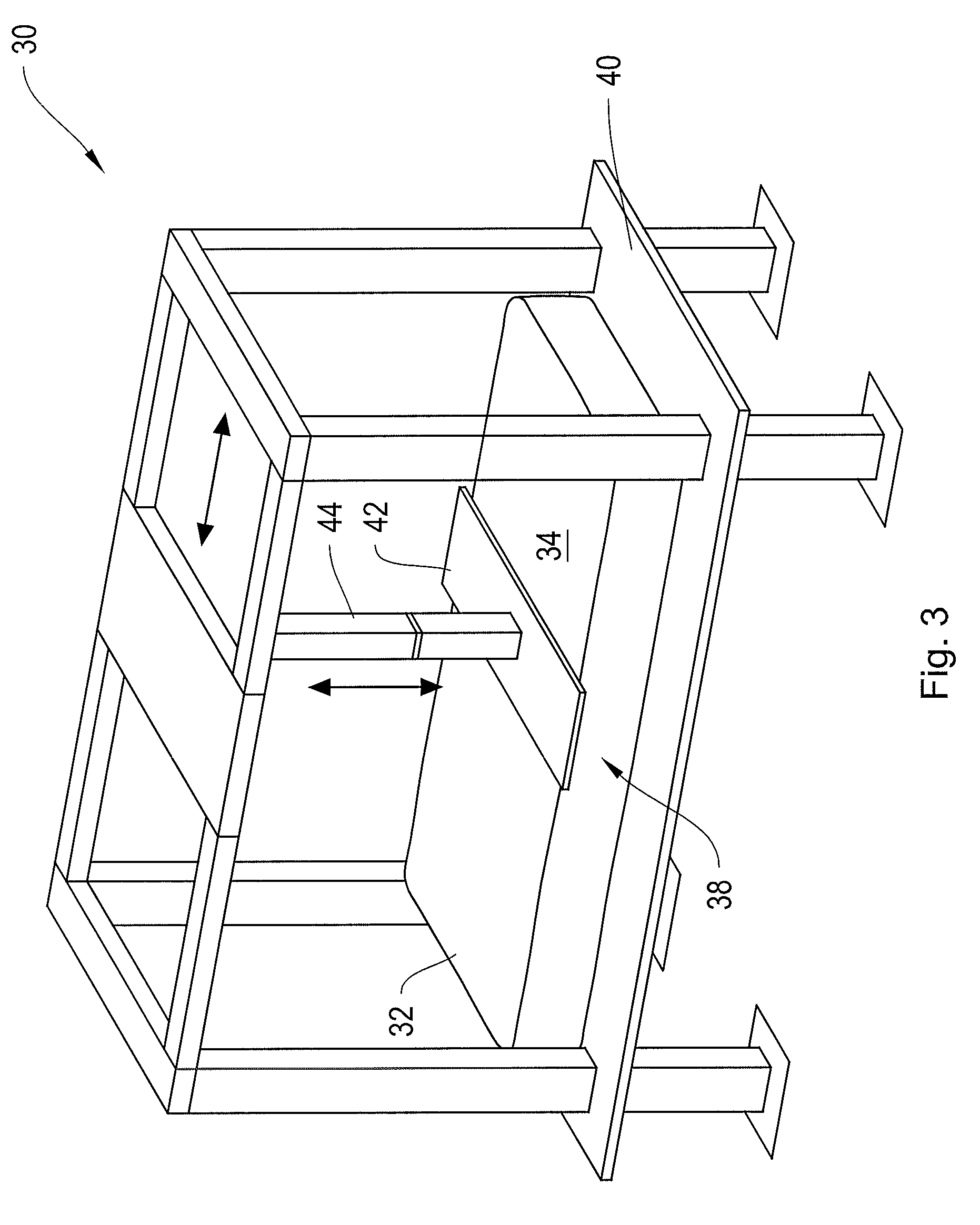[0009]The cell structure thus formed can play an important role in determining the mechanical properties of the foam including its firmness or hardness. Hardness or firmness is typically measured by an indentation force deflection test (IFD), which is a measurement of the load bearing properties of the foam. In this test, a circular plate is depressed into the foam to a desired depth or indentation. The test determines the force required to reach a specified indentation. Alternatively, the circular plate is depressed on a foam pad and applies a specified force. The indentation on the foam pad resulting from the force is measured. However, air may be trapped within the closed cells, and air flow through the foam may be limited if there is a large number of closed or only partially open cells. Consequently, during IFD tests, additional force may be required to force the air out of the foam and the closed cells thereby generating an artificially high hardness or firmness measurement that may change through normal use. If the same foam is then tested again, and again, the hardness is likely to go down a little bit on each successive test cycle because the cell windows in the foam are getting blown open or ruptured allowing air to pass through the foam more freely. Therefore, the IFD test measurements may effectively reflect the temporary pneumatic characteristics of these air-filled closed cells rather than the eventual firmness of the used, aged foam when the cell windows have been broken through regular use.
[0010]Generally, foams used in automotive seating applications tend to be molded foams designed to have a large population of closed cells when demolded. If these cell windows are not crushed open immediately, the foam pad is likely to lose dimensions and shrink. This is because carbon dioxide gas gets trapped in the closed cells, cools down once the foam is demolded and then diffuses out from the cells faster than air diffusing into the cells. Therefore, a pressure differential is generated between the outside and the inside of the cells causing the foam to shrink. To reduce foam shrinkage, molded foam pads intended for automobile seats are passed through rollers immediately after demolding to drive out trapped hot gases such as carbon dioxide and thereby prevent foam shrinkage. However, foams used in mattresses or cushions are not generally not made by such a molding process and consequently are not commonly thought to have carbon dioxide trapped in closed cells. Therefore, foam and mattress manufacturers have not thought to pass foam mattresses or cushioning foam pads through rollers for pre-conditioning and stabilizing firmness.
[0011]As noted earlier, cell windows may be ruptured by repeatedly stressing the material by compressing it and / or stretching it. Although compression of a mattress or foam pad will rupture some of the cell windows present in the foam, compression techniques adapted for use with mattresses or foam pads typically will only compress a mattress or pad in one direction. For most mattresses and pads, this compression generally will be in the direction of the smallest dimension, e.g. the height of a typical mattress in a typical sleeping configuration. In order to increase the extent of cell window rupture, a mattress or foam pad may be stressed along a plurality of physical axes, for example along as many of the three physical axes as possible. The aspect ratios (ratio of two physical dimensions, such as width to height, width to length, or height to length) of typical mattresses and foam pads make roller-based compression in the length and width directions difficult due to buckling in the height direction. However, the very same aspect ratio makes roller-based stretching in the length and width directions possible. The system and methods described herein include compression or stretching techniques, or a combination of both techniques to pre-condition or pre-stress mattresses or cushioning foam pads.
[0013]Accordingly, in one aspect, the invention provides methods of finishing and providing a mattress to a user that comprise providing an unaged mattress assembly having a first foam pad with an initial height and a mattress core, accelerating the aging of the unaged mattress assembly by applying a force to at least a section of the mattress assembly sufficient to temporarily compress its height an amount selected to permanently alter a mechanical property of the foam pad representative of indentation force deflection, disposing the foam pad over the mattress core to provide at least a portion of a sleeping surface over the mattress core, and providing an aged mattress assembly having a firmness that is different from the firmness of the unaged mattress assembly. Optionally, the unaged mattress assembly further comprises a second foam pad with an initial height, and stressing the unaged mattress assembly further comprises applying a force to at least a section of the second foam pad sufficient to compress the height of the second foam pad an amount selected to alter a mechanical property of the second foam pad, and disposing the second foam pad over the mattress core. In certain embodiments, stressing the unaged mattress assembly comprises applying a force to the mattress assembly sufficient to compress the heights of one or more foam pads in the assembly an amount selected to alter one or more mechanical properties of the one or more foam pads after the foam pads have been disposed over the mattress core.
 Login to View More
Login to View More 


